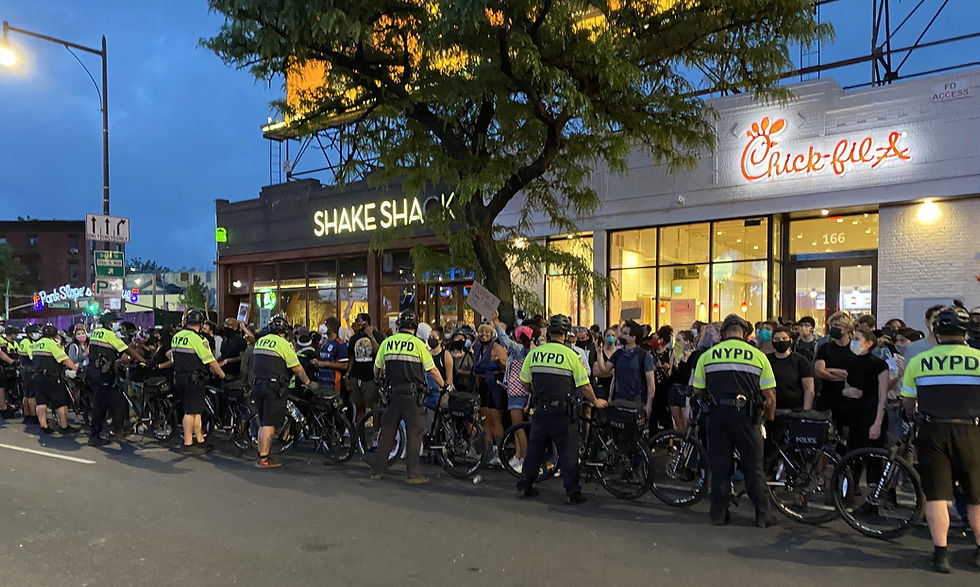Giving Protesters a Pass:
- sglick79
- Dec 20, 2020
- 3 min read
Updated: Dec 20, 2020
A watchdog’s report suggests without “disorder control” tactics, there would have been less “disorder”
By Bill Bratton

The police exist to keep people safe by preventing crime and disorder. That’s a mission dating back nearly 200 years to Sir Robert Peel and the Metropolitan Police. At the same time, our First Amendment promises not to abridge freedom of speech, nor the right of the people peaceably to assemble. That’s an American principle dating back even further, to 1787. When safety, order, speech and assembly collide, police are expected to navigate it in ways that balance everyone’s rights—protestors’ rights to petition for redress of grievances, other people’s rights to move safely about the city, and have their lives, liberty, and property guarded. Police have learned to facilitate, not quell—unless safety is imperiled. For several fraught weeks at the beginning of this summer, the NYPD tried to do just that. Those efforts were made more complicated owing to the fact that the killing of George Floyd in Minneapolis put the police themselves at the heart of the grievances.
Now the Department of Investigation has published a report about the NYPD’s efforts. It’s neither a cheaply critical nor one-dimensional report. It raises valid questions about large-scale arrests in Mott Haven using a technique people outside the NYPD call “kettling.” It gives an accurate recounting of the days and nights of disorder, and it makes some sensible recommendations. But it stands on some broad and unsupported assumptions.
The report’s overarching theme is that the NYPD first used too few and then perhaps too many police officers at the demonstrations. It concludes that the NYPD’s approach to managing the demonstrations was rooted in “disorder control” tactics rather than pursuing an active role as “facilitators” for peaceful protest. The report strongly suggests if there had been less “disorder control” there would have been less disorder. That is a fairly brave assertion. There is no empirical, scientific or factual data to support this conclusion, especially where millions of dollars in property damage occurred. Hundreds of police officers were injured, two dozen police cars were set afire and avenues, bridges and highways were blocked, delaying and trapping thousands in cars. Ignoring that goes against every obligation police have, from service to rescue to ensuring that everyone has equal access to our public sphere, not just those with the loudest voices and biggest banners.
A premise of the DOI’s report is that since the majority of protesters were non-violent, smaller numbers of violent instigators and anarchists within the larger groups somehow would have decided not to throw bricks, break windows or set police cars afire with gasoline —-if only police had given them a wider berth to express their outrage.
These assumptions are contradicted by other cities that didn’t have enough police and that experienced nights of burning, looting, gunfire, significant property loss and some fatalities. In those cities, police countered with rubber bullets, tear gas and armored vehicles. Those are tactics the NYPD never uses. Based on my years of experience, learning from peaceful demonstrations, full-blown riots and everything in between, I know that more officers, properly equipped, mean less violence. Frankly, as the DOI report suggests, in the early days of the demonstrations, the NYPD may not have used as many officers as it should have.
Proper resourcing is critical in order to facilitate peaceful protests or contain civil disorder. During my time as Police Commissioner, after Eric Garner’s death in police custody, the NYPD managed weeks of anti-police protests with patience and carefully measured enforcement. In 2017, the NYPD managed the Women’s March with 400,000 protesters and not a single arrest. The question is, who sets the tone? Is it the protesters or the police?
The DOI report also seems to be in conflict with some of its own conclusions. For instance, the report shows that the NYPD arrested more white people than people of color, but people of color were charged with more serious offenses. This suggests that there was racial disparity in charging decisions. It omits that the burglary and other felony charges were related to the looting of stores—and that the NYPD’s opinion is that the looting was not carried out by actual protesters but rather by opportunists taking advantage of the mayhem surrounding the protests.
The NYPD’s actions have now been examined by the state Attorney General, the Department of Investigation, and soon, the City’s top lawyer, James Johnson. In the meantime, despite flaws in some of the DOI theories, the NYPD has committed to adopt its recommendations. Why? Because the NYPD believes and lives up to the idea that public safety is a shared responsibility.
The NYPD is not a perfect police department. There is no such thing. But it is experienced, professional and constantly learning so that it can continue to do what it has done for 175 years: keeping New Yorkers safe.






Comments